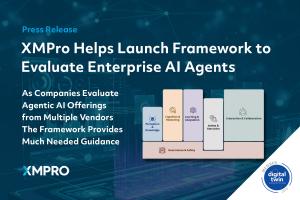
XMPro Helps Launch Framework to Evaluate Enterprise AI Agents in Real-World Deployments
Digital Twin Consortium’s AI Agent Capabilities Framework helps enterprises benchmark agent capabilities and de-risk adoption of AI-powered systems.
XMPro CEO Pieter van Schalkwyk has served as a co-chair in the development of the Digital Twin Consortium's AI Agent Capabilities Periodic Table (AIA CPT), a neutral framework that helps enterprises distinguish between simple chatbot-style tools and truly autonomous systems.
As enterprises move from AI pilots to production-scale deployments, the need for standardization has grown urgent. From basic chatbots to self-directed autonomous agents, every solution is now marketed as "agentic AI." Without a common framework, procurement teams and operational leaders face confusion and risk. The AIA CPT is designed to eliminate ambiguity by offering a structured way to map business requirements to specific agent capabilities.
"There's a growing gap between what agentic AI vendors promise and what their systems can actually deliver," said Pieter van Schalkwyk, who also co-chairs the Object Management Group’s AI Joint Consortia Working Group. "Many solutions are built on top of large language models like OpenAI’s GPTs, Google Gemini, or Anthropic Claude — and integrated via platforms like Microsoft Azure Agents — but not all architectures are created equal.
Some vendors wrap basic prompt chaining and task automation in an agentic label, while others are designing cognitive frameworks that support planning, memory, tool use, and multi-agent collaboration. This framework gives Fortune 500 companies the tools to map their business needs to specific agent capabilities — and critically assess which offerings are architecturally capable of supporting real-world, operational use in the era of agentic AI."
The AIA CPT framework introduces five types of AI agents:
Type 0: Static Automation (rules-based logic)
Type 1: Conversational (Q&A, chat interfaces)
Type 2: Procedural (task execution and workflow automation)
Type 3: Autonomous (self-directed decision-making within set boundaries)
Type 4: Multi-Agent Generative Systems (collaborative systems of AI agents)
These types are evaluated against 45 capability criteria across six categories: Perception, Cognition, Learning, Action, Interaction, and Governance. The toolkit includes YAML configuration samples, Excel evaluation matrices, and user guides, all of which can be adapted to align with enterprise procurement processes.
XMPro, which contributed to the design of the AIA CPT, brings implementation experience across all five agent types — with real-world deployments in water utilities, mining, and energy optimization. Its platform integrates with OpenAI, Microsoft Azure, SAP, and other industrial systems, grounding the framework in operational reality.
The AIA CPT is already being used by companies participating in Digital Twin Consortium’s testbeds — collaborative environments where emerging technologies such as generative AI and multi-agent systems are developed, validated, and deployed. For example, the “Automated Negotiation with Digital Twins & MAGS” testbed explores how AI agents can resolve cross-boundary conflicts in supply chains, while the “cognitive-network-orchestration” testbed demonstrates agent-based digital twins' capability to communicate across industrial and business domains.
"What makes this different is its ability to evaluate AI agent readiness across platforms," van Schalkwyk added. "Whether a company is working with NVIDIA’s Omniverse for simulation, AWS Bedrock for generative AI, or deploying AI in constrained edge environments with Dell, they need to understand the level of agentic AI autonomy they’re actually buying."
With Gartner predicting that 80% of organizations will adopt AI agents by 2027, and vendors expanding their portfolios weekly, the AIA CPT gives enterprises a shared language to evaluate solutions, align internal stakeholders, and de-risk procurement.
The Digital Twin Consortium developed this classification system with input from its Composability Framework Subgroup and AI Working Group, building on its widely adopted Digital Twin Capabilities Periodic Table (DT CPT). The two frameworks are designed to work together to assess intelligent systems that combine digital representations with autonomous behavior.
Why It Matters
The AIA CPT empowers CIOs, digital transformation leaders, and OT engineers to benchmark vendor capabilities, align business and technical teams, and accelerate time to value. It enables buyers to distinguish between enhanced dashboards and true decision-making agents — with the level of fidelity required to safely integrate these systems into industrial operations.
Availability
The full AIA CPT toolkit, including vendor evaluation templates, YAML files, and integration guides, is available from the Digital Twin Consortium's website at https://www.digitaltwinconsortium.org/initiatives/ai-agent-capabilities-periodic-table/
About XMPro
XMPro is a provider of decision intelligence solutions that help organizations manage complexity and operate with greater agility. Our technologies include Agentic AI, Multi-Agent Generative Systems (MAGS), and real-time data orchestration tools that enable autonomous action across digital and physical operations. The company’s APEX platform orchestrates AI agents across all capability levels, from conversational interfaces to collaborative multi-agent systems in Industrial AI deployments. Visit www.xmpro.com. for industrial operations, enabling agentic AI agents to observe, reflect, plan, and act across digital and physical systems. The company’s APEX platform orchestrates AI agents across all capability levels, from conversational interfaces to collaborative multi-agent systems in Industrial AI deployments. Visit www.xmpro.com.
Wouter Beneke
XMPro
email us here
Visit us on social media:
LinkedIn
Facebook
YouTube
X
Distribution channels: Aviation & Aerospace Industry, Energy Industry, Manufacturing, Mining Industry, Technology
Legal Disclaimer:
EIN Presswire provides this news content "as is" without warranty of any kind. We do not accept any responsibility or liability for the accuracy, content, images, videos, licenses, completeness, legality, or reliability of the information contained in this article. If you have any complaints or copyright issues related to this article, kindly contact the author above.
Submit your press release
